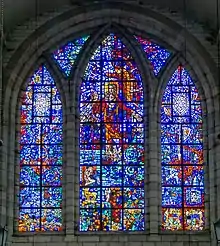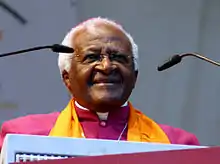Anglican Diocese of Cape Town
The Diocese of Cape Town is a diocese of the Anglican Church of Southern Africa (ACSA) which presently covers central Cape Town, some of its suburbs and the island of Tristan da Cunha, though in the past it has covered a much larger territory. The Ordinary of the diocese is Archbishop of Cape Town and ex officio Primate and Metropolitan of the ACSA. His seat is St. George's Cathedral in Cape Town.[1]
Diocese of Cape Town | |
|---|---|
 | |
| Location | |
| Country | South Africa |
| Ecclesiastical province | Southern Africa |
| Archdeaconries | Cathedral, Athlone, Constantia, Groote Schuur, Ibongoletu, Rondebosch, Waterfront |
| Coordinates | 33°55′30″S 18°25′10″E |
| Statistics | |
| Parishes | 47 |
| Information | |
| Rite | Anglican |
| Established | 1847 |
| Cathedral | St. George's Cathedral |
| Current leadership | |
| Archbishop | Thabo Makgoba, Archbishop of Cape Town |
| Suffragan | Garth Counsell, Bishop of Table Bay |
| Website | |
| www | |


Desmond Tutu was archbishop from 1986 to 1996 and is currently archbishop-emeritus.[2] The current archbishop is Thabo Makgoba.[3] Because of the archbishop's responsibilities as primate, many of his diocesan duties are delegated to a suffragan bishop known as the Bishop of Table Bay, an office currently held by Garth Counsell. (This is similar to the Bishop of Dover in the Church of England Diocese of Canterbury, who has held such a role such 1980.)
History
The diocese came into being in 1847 with the consecration of the first bishop, Robert Gray, and was the first diocese of what was to become the Church of the Province of Southern Africa and subsequently the Anglican Church of Southern Africa. The original territory of the diocese, which had previously fallen under the Diocese of Calcutta, included the whole of Southern Africa.
In 1853, the territory was reduced by the creation of the Diocese of Grahamstown in the eastern parts of the Cape Colony and the Diocese of Natal in the Colony of Natal. In 1859, the Diocese of St Helena was created for Saint Helena and Ascension Island. In 1863, the Diocese of Bloemfontein was created, taking over all the territory north of the Orange River and the Drakensberg mountains. In 1866, J. Harries Thomas was archdeacon of Cape Town and H. Badnall, archdeacon of George; and N. J. Merriman, archdeacon of Bloemfontein (by then separated) was still a canon of Cape Town cathedral.[4] The territory of the Cape Town diocese was further reduced in 1911 by the creation of the dioceses of George and Kimberley and Kuruman. Finally, in 2005 the diocese was divided into three, with the part to north of the city of Cape Town becoming the Diocese of Saldanha Bay and the part to the east of the city becoming the Diocese of False Bay.
Parishes
- Cathedral Archdeaconry
- Archdeaconry of Athlone
- St Mark the Evangelist, Athlone
- St John, Crawford
- St Dominic, Hanover Park
- The Holy Nativity, Hazendal
- All Saints, Lansdowne
- St Aidan, Lansdowne
- St George the Martyr, Silvertown
- Archdeaconry of Constantia
- St Martin, Bergvliet
- Christ Church, Constantia
- St Luke, Diep River
- Christ Church, Kenilworth
- St Philip, Kenwyn
- Holy Spirit, Kirstenhof
- All Saints, Plumstead
- St Faith, Plumstead
- St Cyprian, Retreat
- St Andrew, Steenberg
- Emmanuel, Wynberg
- St John, Wynberg
- Archdeaconry of Groote Schuur
- St Mark, Cape Town
- St Philip, Cape Town
- St Michael and All Angels, Observatory
- St Luke, Salt River
- All Saints, Woodstock
- St Bartholomew, Woodstock
- St Mary the Virgin, Woodstock
- Archdeaconry of Ibongoletu
- Church of the Resurrection, Bonteheuwel
- Eluvukweni Mission, Crossroads
- St Columba, Guguletu
- St Mary Magdalene, Guguletu
- Church of the Holy Spirit, Heideveld
- St Cyprian, Langa
- Church of the Reconciliation, Manenberg
- Holy Cross, Nyanga
- Archdeaconry of Rondebosch
- Christ the King, Claremont
- St Matthew, Claremont
- St Saviour, Claremont
- St Peter, Mowbray
- St Andrew, Newlands
- St Paul, Rondebosch
- St Thomas, Rondebosch
- Archdeaconry of Waterfront
- St Peter, Camps Bay
- St Paul, Cape Town
- Church of the Ascension, Devil's Peak
- St Barnabas, Gardens
- St Peter the Fisherman, Hout Bay
- Church of the Holy Redeemer, Sea Point
- St James the Great, Sea Point
- St Mary, Tristan da Cunha
List of Bishops and Archbishops
| Bishops of Cape Town | |||
|---|---|---|---|
| From | Until | Incumbent | Notes |
| 1847 | 1873 | Robert Gray | In 1853 resigned his overlarge diocese and received fresh letters patent for a new, smaller diocese. |
| 1874 | 1897 | William West Jones | Became Archbishop of Cape Town. |
| Archbishops of Cape Town | |||
| 1897 | 1908 | William West Jones | Died in office. |
| 1909 | 1930 | William Carter | Previously Bishop of Zululand and then of Pretoria. |
| 1931 | 1938 | Francis Phelps | Translated from Grahamstown; died in office. |
| 1938 | 1948 | Russell Darbyshire | Translated from Glasgow and Galloway; died in office. |
| 1948 | 1957 | Geoffrey Clayton | Translated from Johannesburg; died in office. |
| 1957 | 1963 | Joost de Blank | Translated from Stepney. |
| 1964 | 1974 | Robert Selby Taylor | Previously Bishop of Northern Rhodesia, then of Pretoria, then of Grahamstown; later Bishop of Central Zambia. |
| 1974 | 1981 | Bill Burnett | Previously Bishop of Bloemfontein and then of Grahamstown. |
| 1981 | 1986 | Philip Russell | Previously Bishop of Port Elizabeth and then of Natal. |
| 1986 | 1996 | Desmond Tutu | Previously Bishop of Lesotho and then of Johannesburg; now Archbishop emeritus (of Cape Town). |
| 1996 | 2007 | Njongonkulu Ndungane | Translated from Kimberley and Kuruman. |
| 2007 | present | Thabo Makgoba | Translated from Grahamstown. |
Assistant bishops
From 1931, Sidney Lavis was coadjutor bishop of the diocese.[5] In 1964, Patrick Barron became an assistant bishop of the diocese.[6]
Schools
The Diocese has four diocesan schools:
Coat of arms

The diocese has borne arms since its inception. The arms, designed by Bishop Gray, combined elements of those of the dioceses of Durham (where Gray had been Bishop) and Bristol (his first chaplaincy, when his father was Bishop of Bristol) and of Baroness Burdett-Coutts, who financed the establishment of the diocese.
In their original form, the arms were : Quarterly Azure and Sable: I and IV, a lion rampant Argent; II and IV, three open crowns palewise Or; on a cross throughout Or an anchor in fess point Sable and in honour point the shield of arms of Baroness Burdett-Coutts; the shield ensigned with a Bishop's mitre proper.
The arms were revised by the College of Arms and granted in 1952. The revision consisted of replacing the Burdett-Coutts shield with a stag's head erased Gules, between the attires a pheon Azure. These arms were registered at the Bureau of Heraldry in 1968.[7]
References
- St Georges Cathedral website
- "Archbishop Emeritus Mpilo Tutu". South African History Online. 4 April 2011. Archived from the original on 14 September 2017. Retrieved 2017-09-19.
- Fisher, Ryland (18 June 2013). "Maverick interview: Archbishop Thabo Makgoba". Daily Maverick. Retrieved 2017-09-19.
- The Clergy List for 1866 (London: George Cox, 1866) pp. 436–440
- The Living Church Annual. Morehouse-Gorham Company. 1957. pp. 381–.
- "Retrospect of 1964". Church Times (#5316). 1 January 1965. p. 16. ISSN 0009-658X. Retrieved 4 September 2019 – via UK Press Online archives.
- Brownell, F. G. (2002). Heraldry in the Church of the Province of Southern Africa, 1847-2000: Coats of Arms of the Dioceses, Collegiate and Parish Churches, and the Order of Ethiopia. Heraldsholme CC. p. 18. ISBN 978-0-620-28606-0.